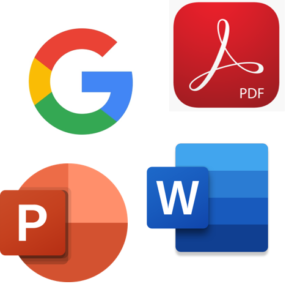Creating Accessible RESources Guide
The Mason CARES guide offers a step-by-step approach to assist faculty with creating accessible instructional content. This resource provides guidance on making the learning platform more accessible, creating accessible instructional resources (i.e., documents, audio, video), selecting accessible supplemental applications, and posting accessible social media content.
Consider the following steps in your course development process:
Step 1: Start with the LMS!
 To access the instructional resources in your course, students must first be able to navigate it. This is especially true for students who navigate using only the keyboard, screen reader users (i.e., blind/low vision), or those easily confused by poorly structured online courses (e.g., students with cognitive challenges). The following resources will assist you with ensuring your LMS is as accessible and usable as possible to our students:
To access the instructional resources in your course, students must first be able to navigate it. This is especially true for students who navigate using only the keyboard, screen reader users (i.e., blind/low vision), or those easily confused by poorly structured online courses (e.g., students with cognitive challenges). The following resources will assist you with ensuring your LMS is as accessible and usable as possible to our students:
Accessible synchronous online learning and collaboration tools can make learning easier and more accessible to individuals with disabilities. They reduce the need to travel to campus and allow students to use their personal computers equipped with assistive technology hardware are software they need.
For guidance on how to make your web conferencing sessions more accessible, review the following resources:
Step 2: Documents! Documents! Documents!
 Word, PowerPoint, and PDF are the most common document formats used in online courses at Mason. This includes not only course syllabus, but articles, presentations, and course assessments. The following resources offer guidance on how to ensure the documents used in your online course are as accessible as possible to our students:
Word, PowerPoint, and PDF are the most common document formats used in online courses at Mason. This includes not only course syllabus, but articles, presentations, and course assessments. The following resources offer guidance on how to ensure the documents used in your online course are as accessible as possible to our students:
Creating accessible electronic documents ensures equivalent access to instructional resources by persons with print disabilities. The most common document formats used in Mason classrooms are Word, PowerPoint, and PDF.
To make your documents accessible, please review the resources below:
Step 3: Creating Accessible Podcasts and Videos
 Audio and video content are a core part of any online course. Making these resources accessible benefits many different types of learners, not just those with hearing loss. The following resources offer guidance on how to ensure the audio and video resources used in your online course are as accessible as possible to our students:
Audio and video content are a core part of any online course. Making these resources accessible benefits many different types of learners, not just those with hearing loss. The following resources offer guidance on how to ensure the audio and video resources used in your online course are as accessible as possible to our students:
To learn more about creating accessible multimedia content, please review the following:
Step 4: Supplemental Applications – Are they accessible?
That question is a bit loaded. In other words, it all depends on the application(s) that you plan to use in your course. The ATI can assist by working with you to determine how your particular use case could impact some students with disabilities taking your course. Submit a request for a Website/Software Applications Accessibility Review on our website. We will test your resource and provide feedback on our test results. If necessary, we will work with you on alternative solutions.
The following resources offer guidance on some of the more commonly used supplemental applications:
- Resources will be coming soon…
Step 5: Making your Social Media Content Accessible
 Below, we have highlighted some resources to aid with making your social media content accessible. Please check back often as we will update this content regularly.
Below, we have highlighted some resources to aid with making your social media content accessible. Please check back often as we will update this content regularly.
The following resources offer guidance on ensuring your social media content is as accessible:
Start with general platform-agnostic considerations:
Additional platform-specific guidance is listed below:
Still have questions?
This is by no means an exhaustive resource. It is, however, a good start toward ensuring your instructional resources are as accessible as possible to everyone. If you still have questions, please contact the ATI.
For faculty/staff who may have difficulty managing some of these tasks on their own, the ATI has resources to help. See our Request ATI Services page for more details.
